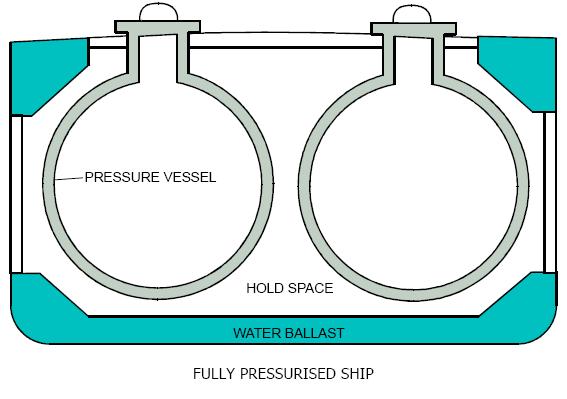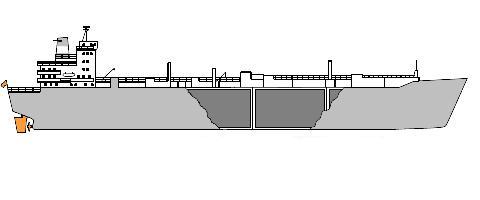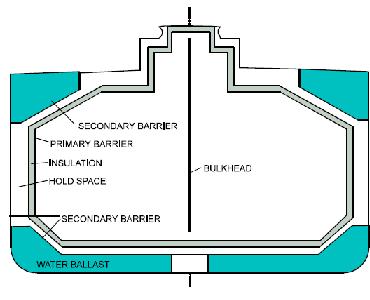

Home page|||
LNG handling |||
LPG handling||| Other Gas products|||
Fire & Safety|||
Emergency response |||
Ballast operation at sea & ballast exchange requirement & more guideline
When the ship is not carrying cargo or is lightly loaded, sufficient ballast must be carried to ensure that
the ship’s stress, stability, draft, trim and propeller immersion is within permissible limits to guarantee
the safe handling of the vessel in the prevailing or expected conditions.
In meeting these parameters the vessel must comply, at least, with the requirements of the IMO, Class
(especially appendix to Class Certificate) and Port State Authorities.
In 1993 IMO has adopted Resolution A.774 (18) “Guidelines for Preventing the Introduction of
Unwanted Aquatic Organisms and Pathogens from Ships’ Ballast Water and Sediment Discharges”. The
procedures that the Company view as the most practical to comply with this IMO Resolution are
described in this section, and Masters are to ensure compliance with them.
Ballast operations must always be carried out within the capabilities of the vessel and its systems and if
the vessel is unable to follow ships management ashore is to be advised.

Planning of the Ballast Operations
The Chief Officer is normally designated to carry out ballast procedures and maintain all records as required.
The Master is to ensure the Chief Officer is familiar with the requirements of ballast handling including IMO
Guidelines. The Master must also ensure that all the crew members are given the instruction and are
aware of the need for ballast water control procedures and the procedures being adopted on board.
Ballast operations are always to be planned in advance by the Chief Officer and entered on the Cargo
Loading and Discharge Plan . The plan is to be approved by the Master prior to
commencing the operation. In port, the plan must be discussed and agreed with the terminal
personnel.
Each vessel must produce a standard plan for a complete ballast change which should include the
following elements, stress calculations, any restrictions on deck access during operations, the
supervision of the operations, communications, line and valve settings, venting arrangements and
ullage monitoring.
Records and Reporting
When taking on ballast waters, the date and time of commencement and completion of the ballast
operation, ship’s position, salinity (specific gravity) and amount of ballast water taken onboard must be
recorded in the ship’s Deck Log Book.
A report in the format shown in the appendix to IMO Guidelines must be completed by the Master and
made available to the Port State Authority on request. Analysis certificates, ballast reports and shore
receipts must always be kept on board in a separate file.
When the Port State Authority water ballast control requirements (e.g. exchange of ballast at sea)
cannot be met during the voyage due to weather condition, operational impracticability, etc, the Master
must report this fact to the Company and the prospective Port State Authority prior to entering its
national waters (economical zone), so that appropriate alternative action can be arranged.
Controls Applied by Port State Authorities
The Master is to check in advance with the local agent, and the latest Port Guide, for any information
on ballast water sediment discharge procedures, being applied by the State Authorities at an expected
port of call. These procedures may include, but are not limited, the following control actions:
- The non-release of ballast water;
- Ballast water exchange and sediment removal at sea or in acceptable areas;
- Ballast water management practices aimed at minimising the uptake of contaminated water in
ballasting and deballasting operations;
- Discharge of ballast water into shore-facilities.
Failure to comply with national requirements may lead to unnecessary delays for the ship. In some
cases penalties may be applied by Ports State Authorities. The vessel may be required to proceed to
an approved location to carry out the necessary exchange, seal the ballast tanks against discharge in
the Port State’s waters, pump the ballast water to shore reception facilities, or prove by laboratory
analysis, that the ballast water is acceptable.
Loading of Ballast Water
When loading ballast every effort is to be made to ensure only clean ballast is being taken onboard and
the intake of sediment is minimised. Where practicable vessels are to avoid taking on ballast water in
shallow water areas or in the vicinity of dredging operations.
Vessels must not ballast if at all practicable in areas where there is a known outbreak of water
communicable diseases or where phytoplankton blooms are occurring.
It is recognised however, that when vessels trade to river or estuary ports, intake of some silts and
sediments is unavoidable. In such situations the amount of silt taken on board can often be
substantially reduced by planning to ballast on the flood tide when the suspended silt levels are
normally lower.
Vessels taking on ballast in river or estuary waters or any other areas where the purity of the water is
in doubt, including areas of probable contamination from chemicals, disease, pathogens etc. must
follow the control procedures as described below.
When segregated ballast has been loaded in stilted or otherwise polluted water, the ballast is to be
changed as soon as possible after leaving that port. It is also essential that this is carried out to
prevent the build up of mud in ballast tanks which may reduce the vessels cargo lifting capacity.
Whenever possible the initial filling of the ballast tanks should be running in from the sea by gravity in
preference to pumping in.
In general, segregated ballast tanks are to be filled to 100% capacity but not be overflowed.
Ballast Water Exchange and Sediment Removal
The most realistic and practical method for the control of transportation of marine organisms and to
control sediments, is to exchange ballast water in deep ocean or open sea areas. This will limit the
probability that fresh water or coastal species will be transferred in the ballast water. The responsibility
for deciding on such action rests with the Master. The Master must contact the Port State Authority of
his next port via the agents and determine if special control actions are required.
The exchange is to be conducted in water depths greater than 2000 metres, or in those cases where
this is not possible, exchange of ballast water is to be made well clear of coastal and estuary
influences.
Draining of each tank is to be done until pump suction is lost. This will minimise the likelihood of
residual organism survival. The tank is then to be flushed over the bottoms by refilling (if possible – by
gravity) to approx. 0.5 metre depth, twice, each time followed by complete draining until pump suction
is lost. The tank is then to be refilled. The effectiveness of this flushing can be increased if the vessel
is on a course that causes the vessel to roll slightly, however, the vessel must not deviate greater than
15o from the intended voyage course during the time of flushing.
When heavy sedimentation is observed after visual inspection, then manual sediment removal may be
undertaken. Tanks shall be inspected visually for sediment build up at least once every three months
wherever practical, and sediment build up recorded on the tank condition report which is to be
forwarded to the Company.
Flow Through Exchanges
When a vessel cannot conduct a complete ballast change, a “flow through” (through ballast tank vents)
exchange of ballast water may be an acceptable alternative for some tanks, however, it has little effect
on sediment control.
Due to the risk of building up the pressure in ballast tanks, and the possibility of damage to vent heads,
screens, etc. this procedure would require Administration (Classification) approval and must not be
attempted without prior special considerations and authority of the Company. Modification of tank
venting arrangements may be necessary to avoid damage to the vent heads and screens.
Discharge of Ballast Water
No ballast is to be discharged in the continental shelf, coastal or port waters where ballast water and
sediment control measures are being applied by State Authorities, the ballast water and sediment
control procedures have been followed, or acceptable alternatives have been adopted.
The effectiveness of the vessels procedures may be verified by Port State Authorities taking samples of
ballast water and/or sediments from the vessel, to test for the continued survival of unwanted aquatic
organisms and pathogens. Such samples may also be taken from suction wells, chain lockers and other
areas where sediment may accumulate. In certain cases discharge of ballast will not be permitted until
analysis of such samples is completed. The Master is to ensure that relevant written authorisation is
obtained from the Port Authority prior to discharging any ballast to coastal waters of any country that
exercises ballast control measures.
Shortly after commencement and during discharge of any ballast overboard the surface of the sea is to
be checked frequently to guard against accidental pollution.
Whenever possible, initial deballasting of SBT is to be by gravity in preference to pumping out.
Sample Analysis Certificate
Vessels may avoid ballast changing in some circumstances by having their ballast water or harbour
source samples analysed by a laboratory at the departure port. Where the analysis shows the ballast
or sediment to be free from unwanted aquatic organisms or pathogens an analysis certificate is to be
provided by the Master to the
Port State of arrival. This must be carried out by fax several days prior to arrival in case the analysis is
rejected, so that the ballast change procedures can be applied prior to arrival.
Manual Removal of Solid Elements
Care is to be taken when manually removing sediments while the ship is in port or in continental shelf
waters, to ensure sediments are not discharged into these waters. Sediments must be disposed of
ashore and processed according to the local requirements. A log book entry is to be made and receipts
obtained.
This part applies to solid sediment discharges, and does not affect sediments that can be removed from
the chain locker or wells by hand hosing.
Ballast Operation Precautions
Personnel Safety :
If tank entry is required to affect the taking of samples, carrying out a ballast tank inspection, or for
manually removing solid sediments, then all the safety precautions and “Entry into Enclosed Space”
Entry Permit Form Requirements must be complied with.
Ship’s Safety :
When planning and carrying out operations with ballast waters, the following factors must be taken into
account:
- Shear Force and Bending Moment
- Stability and Free Surface Effect
- Slack Tanks
- Torsion Loads
- Draft and Trim of the Vessel
The Ship’s course and speed is to be properly set depending on the prevailing weather conditions.
Sufficient personnel must be available to allow safe monitoring of the operation.
Ballast Tank’s Venting System
It is of paramount importance that all segregated and permanent ballast tank vents are properly set up
and in good condition prior to any ballast operation. All vent closures that are capable of manual
operation must be in the open position. The original design venting capability must be available at all
times.
The vents are to be further checked soon after starting the operation to confirm that the tanks are
venting freely. Improperly set ballast vents can result in severe structural damage to the vessel.
Vent screens are to be kept free from paint as this can seriously reduce their volumetric capacity.
Great care is to be taken in conditions where icing is occurring. In certain circumstances screens on
ballast tank vents can become blocked by icing. During ballast operations in such conditions, the
responsible officer is to ensure that all precautions are adopted to ensure the free venting of ballast
tanks, and that regular checks are made to ensure continuous free venting throughout the operation.
Pumping Limitation
During pumping of ballast care must be taken not to operate the pumps above the maximum safe rate.
In this respect the ballast pump capacity must be borne in mind with respect to the maximum
ballasting rate of any given tank or sets of tanks.
When ballasting at sea in heavy weather, there is a significant risk to personnel on deck and it may be
more prudent to “run in” the ballast by gravity to a number of tanks.
Cathodic Protection
Uncoated clean ballast tanks have a sacrificial zinc anode system fitted to protect the entire tank
structure.
Uncoated dirty ballast tanks have a sacrificial zinc anode system fitted to protect the bottom shell
plating only to guard against pitting.
CBT product carriers with coated tanks have anodes fitted in designated ballast tanks, sufficient only to
protect the tank coatings and the underlying steel in the event of a coating breakdown. Care must be
taken to avoid over protection in the tanks as this can lead to coating breakdown.
It is important that ballast is loaded into protected tanks only, and any deviation from this requirement
in order to affect ballast control procedures must receive approval from the Company.
If loading ballast into tanks fitted with cathodic protection in a freshwater river or estuary it is also
important to change the ballast at sea as soon as practical in order to achieve the full effect of the
cathodic protection system.


Fig: 75,000 m3 fully refrigerated LPG tanker with self supporting prismatic tank
Reference Publications
-
MARPOL 73/78
-
IMO Resolution A.774(18) – “Guidelines for Preventing the Introduction
of Unwanted Aquatic Organisms and Pathogens from Ship’s Ballast
Water and Sediment Discharged”
- Ship specific Ballast Water Management Plan and Log
-
Ship’s “Dedicated C.B.T. Operations Manual” (Approved by Class)
-
Ship’s “Procedure and Arrangements manual” (Approved by Class)
-
International Safety Guide for Oil Tankers and Terminals (ISGOTT)
-
Clean Seas Guide for Oil Tankers
-
Guide to Port Entry
Related Information:
-
Risk of ballast voyage for gas carriers
- Risk of partially filled ballast tanks
- Compressed gas liquid carriers (CGLC)
- Development and potential of todays emerging gas technologies
- Transporting economically viable compressed gas liquids from remote fields
- Increased Cargo Capacity for LNG ships & Advantages of the dual fuel diesel electric propulsion

// Home page///
LNG handling ///
LPG handling///
Sea transport ///
Gas products///
Cargo work
///Fire precautions
///Health hazards
///Safety Precautions
///Emergency response ///

Copyright © Liquefied Gas Carrie.com All rights reserved.
The content published in this website are for general reference only. We have endeavoured to make the information as accurate as possible but cannot take responsibility for any errors. For latest information please visit www.imo.org . Any suggestions, please Contact us !
//Links &Resources //
Terms of use//
Privacy policy //Home page
